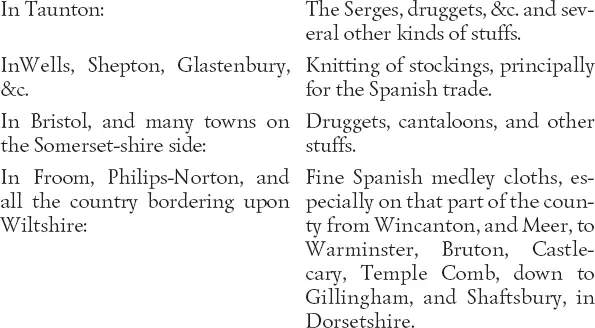And in one place they shewed us, where a ship was, by the force of the water, and the rage of the tempest, driven up upon the shore, several hundred yards from the ordinary high water mark, and was left in that surprizing condition upon dry land.
As this country is all a grazing, rich, feeding soil, so a great number of large oxen are fed here, which are sent up to London; so that now we come into the reach of my former observation, viz. That every county furnishes something for the supply of London, and no county in England furnishes more effectual provisions, nor, in proportion, a greater value than this. These supplies are in three articles.
1. Fat oxen (as above) as large, and good, as any in England.
2. Large Cheddar cheese, the greatest, and best of the kind in England.
3. Colts bred in great numbers in the moors, and sold into the northern counties, where the horse copers, as they are called, in Staffordshire, and Leicestershire, buy them again, and sell them to London for cart horses, and coach horses, the breed being very large.
As the low part of this county is thus imployed in grazing and feeding cattle, so all the rest of this large extended country is imployed in the woollen manufactures, and in the best, and most profitable part of it, viz.

I mention this at large, because this trade of fine Spanish medley cloth, being the mix’d colours and cloths, with which all the gentlemen and persons of any fashion in England, are cloth’d, and vast quantities of which are exported to all parts of Europe, is so very considerable, so vast an advantage to England, maintains and supports so many poor families, and makes so many rich ones, that no man can be just in the description of things, and in a survey of this part of England, and not enter into a particular description of it; the above you may take as an introduction to it, only I shall add but a little more, concerning this county of Somerset, and shall, upon my entering into the north-west and west parts of Wiltshire, where the center of this prodigy of a trade is, sum it all up together, and shew you the extent of land which it spreads itself upon, and give you room, at least, to make some guess at the numbers of poor people, who are sustain’d and inrich’d by it.
But I must first go back again a little while into Somersetshire: The northern part of the county, I did not visit in this journey, which, as I hinted before, is only a return from my long travel to the Land’s End. In omitting this part, I, of course, leave the two cities of Bristol and Bath, and that high part of the county called Mendip Hill, to my next western journey, which will include all the counties due west from London; for these now spoken of, though ordinarily called the west country, are rather S. W. than west.
But as I made a little trip from Bridgewater north, into the body of the county, I must take notice of what I observed in that part of it: The first place I came to was Glastenbury, where, indeed, the venerable marks of antiquity, however I have declined the observation of them, struck me with some unusual awe, and I resolved to hear all that could be told me upon that subject; and first they told me (for there are two pieces of antiquity, which were to be inquired of in this place) that King Arthur was buried here, and that his coffin had been found here.
Secondly, that Joseph of Arimathea was here, and that when he fix’d his staff in the ground, which was on Christmas Day, it immediately took root, budded, put forth white-thorn leaves, and the next day, was in full blossom, white as a sheet, and that the plant is preserved, and blows every Christmas Day, as at first, to this very day.
I took all this ad referendum , but took guides afterward, to see what demonstrations there could be given of all these things; they went over the ruins of the place with me, telling me, which part every particular piece of building had been; and as for the white-thorn, they carried me to a gentleman’s garden in the town, where it was preserved, and I brought a piece of it away in my hat, but took it upon their honour, that it really does blow in such manner, as above, on Christmas Day. However, it must be confessed, that it is universally attested.
Where I had the sight of the white-thorn tree, I obtained a sight of Mr. Cambden, and his continuator, and was, at first, a little concern’d, that a person of Mr. Cambden’s judgment, gave such an account of the legendary part of the history of this place, with a taste of his crediting the whole story; and from him I began to believe also, that Joseph of Arimathea, was really here, and that the Christian religion was preached in this island within thirty seven years after the death of our Saviour.
This, however, prompted me to farther inquiry, and the following account occurred, which is to be found, as they say, in the manuscript History of the Church of Glastenbury, now deposited in the Cottonian Library, and taken from it by Mr. Dugdale, in his Monasticon. Fol. 1, 2.
Glastonbury Monastery in Somersetshire, of the Order of St. Benedict
In the year 31 after the Passion of our Lord, twelve of St. Philip the Apostle’s disciples (the chief of whom was Joseph of Arimathea) came into this country, and preached the Christian faith to Arviragus, who refused to embrace it, and yet granted them this place, with twelve hides of land; where they made walls of wattles, and erected the first church in this kingdom, which Christ personally dedicated to the honour of His Mother, and the place for burial of His servants, as is said in the manuscript History of the Monastery of Glastenbury in the Cotton Library. These twelve, and their successors, continuing long the same number, and leading an eremetical life, converted a great multitude of pagans to the faith of Christ. They being all, at length, dead and buried here, the most holy men Phaganus and Diruvianus, coming into these parts, and baptizing King Lucius and his people, had the aforesaid hides confirm’d to them and their successors, the same number of twelve being kept up ‘till the coming of St. Patrick, who, instructing them in the monastical life, became their abbot: After whom, the holy fathers Benignus, Kolumkil, and Gildas, led a most holy life there. Next came St. David Archbishop of Menevia, now called St. David’s, who added a new chapel to the church, dedicating it to the blessed Virgin, and erected a rich altar; and near the said chapel, Joseph of Arimathea, and other holy men, are said to have been buried. Tho’ the church was afterwards several times rebuilt, this place still remained under the former consecration, and was held in such veneration, that kings, bishops, and all the greatest persons, thought themselves happy in adding something to its possessions, or being buried with any small parcel of its earth. St. Dunstan, and other holy abbots, always preserving the number of twelve monks, added to them several clergymen that sung well.
This church, by reason of its antiquity, was by the English called Ealdchurch, that is, Old Church; and the people of the country about it, thought no oath more sacred, than to swear by the Old Church; as being the first, and oldest church in England, and held in such veneration, that it was called a second Rome, for sanctity; because, as Rome was honoured with a multitude of martyrs, so this place was renowned for many confessors.
This island, in which this church stands, was, by the Britons, first called Ynswyxtryn, that is, the Glass Island, by reason of the river, as it were of the colour of glass, incompassing the marsh. It was called an island, because inclosed about by a deep marsh. It was called Avallonia, either from the British word aval , signifying an apple, as being full of fruit-trees, or from Avallon, who was once lord of that territory. The Saxons gave it the name of Glastingebury, that is, the Town of Glass. There are several islands about this, all belonging to it, all which together were reduced to make up the twelve hides above-mentioned, the bounds whereof may be seen in Dugdale, p. 2. and 3. All the places within those bounds enjoy all sorts of immunities, from the first times of Christianity, granted and confirmed to the church of Glastonbury by the British, English, and Norman kings.
Читать дальше













